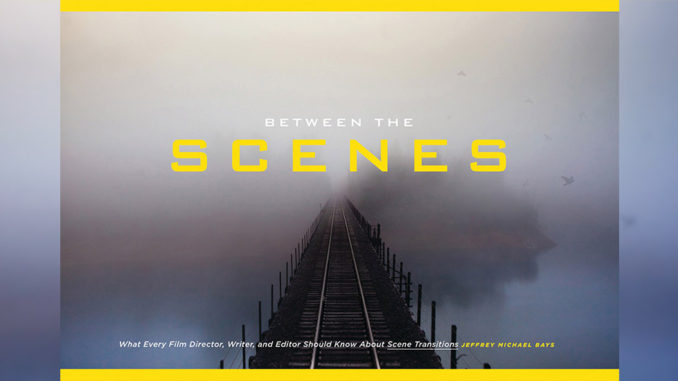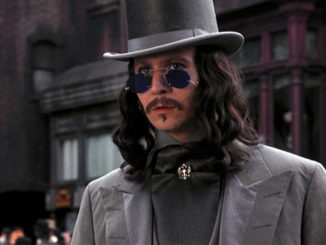
by David Tarleton
During picture editing, working out the logistics of navigating between scenes can be a real puzzle. The editing process usually involves cutting individual scenes first, and then working out transitions between scenes when they are put together. When the director has designed shots to create opportunities for meaningful ways to bridge scenes, it can create dynamic filmmaking. It’s not at all uncommon, however, for transitions to be mostly the editor’s focus, and developed in the editing room.
Jeffrey Michael Bays, in Between the Scenes: What Every Film Director, Writer and Editor Should Know About Scene Transitions, tries to remedy that. Writing a kind of instructional book of possible ways of navigating transitional and interstitial moments, Bays gives specific advice separately for writers, directors and editors about each kind of transitional element, including travelling shots, montages, establishing shots, interstitial elements, music and so forth. Pointing out that transitions between scenes are something that many filmmakers only think about when it’s too late, Bays lays out a methodology for creatively approaching transitions, using numerous examples from films.
The author discovered his interest in this topic when, as he edited his first feature-length film, he realized just how much he had overlooked scene transitions during his development and production phases as director. He searched around for a book to help him learn the craft of scene transitions, and discovered that there wasn’t one; so he decided to research it himself, and that grew into his Master’s Thesis, which was the basis for this book. His research consisted of watching a lot of films, reading all the books he could find and analyzing scene transitions looking for universal principles across different films and filmmakers.
The obvious challenge to this approach, when writing a book for filmmakers and not viewers or critics, is that Bays is relatively inexperienced as a filmmaker himself. He has made one film, and it shows in some of his observations and his use of language. In spite of that, as an analysis of the techniques that a lot of other filmmakers have used, he has a lot to say. He’s not so much a filmmaker describing what has worked well for him so much as someone who has deeply analyzed a lot of films looking for patterns — and has found them.
Part of what Bays outlines is for filmmakers to get beyond thinking of scenes as only compartmentalized, isolated moments, and rather to think of them within larger questions of rhythm, emotional payoff and movement, as a principal structural element. Instead of only using instinct and luck, he suggests applying craft to transitions.
For a film student, this book could help foster a more holistic view toward overall film structure.
“A scene transition…is the boundary generated between two scenes…and reaches deep into the areas on either side of that boundary. It includes the movements of the characters [and] the revelation of plot information, as well as all visual, aural and musical elements that play into shifts in time and space,” he writes. “Most importantly, a scene transition is change.”
Not just a how-to book on navigating the edit point between scenes, Between the Scenes provides an alternative way of thinking about narrative construction. Rather than thinking about plot points, Bays’ organizing principle is that scenes are events, and the transitional moments are the opportunity for the audience to internalize the character’s emotional reaction to those events. Focusing this way creates an ebb and flow of intensity and narrative information within the film. I would say that many editors already work in these kinds of ways intuitively, but Bays, through extensive research, is able to suggest a systematic approach.
In this context, the book covers an idea that’s actually broader than how most filmmakers generally think of the words “scene transition.” For example, he analyzes an eight-minute sequence in Ridley Scott’s Gladiator and refers to it as a “scene transition,” which is stretching the term quite a bit from the way filmmakers generally use it. On the other hand, this analysis demonstrates many of the points he makes in the book, and is a useful illustration.
Which leads to the issue with the book’s use of language. It is full of idiosyncratic terminology, which I can only assume is because this was originally written as a Master’s Thesis at an Australian film school. For example, he uses the term “time collage” throughout, when he’s talking about “montage.” He also uses the term “shock cut” repeatedly, when he’s just talking about “hard” or “straight cuts.” The word “interstitial” appears nowhere, in spite of it being a commonly used term to discuss the space between scenes. Instead, Bays coins his own words. He has the impulse to reinvent the wheel, and write as if he is discovering these concepts for the first time.
Jeffery Michael Bays searched around for a book to help him learn the craft of scene transitions, and discovered that there wasn’t one; so he decided to research it himself, and that grew into his Master’s Thesis.
As a result, I think this book is most applicable for beginning filmmakers — principally directors — to set up ways of thinking about transitions being primarily focused on emotion and audience involvement. For a film student, I could imagine that this book could help foster a more holistic view toward overall film structure, particularly on the interstitial moments.
However, even for experienced filmmakers, there are nuggets of wisdom here. I think the book has merit, but it could have benefited from bringing the language and concepts more in line with standard terminology.





